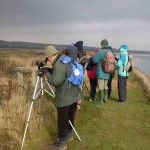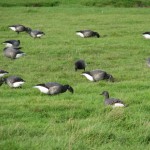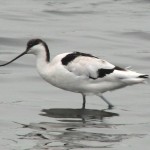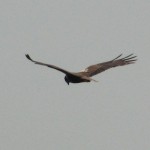On Saturday 22rd January, Martin Sell led a joint field trip of the Berkshire, Buckinghamshire and Oxfordshire Wildlife Trust (BBOWT) and Reading and District Natural History Society to Farlington Marshes near Portsmouth. The exposed mud was slowly being covered by a rising tide as the group set out. It was a cold morning with a light north-easterly wind. A flock of Avocets were seen in the distance and many Brent Geese were feeding on the mudflats, together with Pintail, Shelduck, Wigeon and Teal. On the first lagoon, a larger pale wader amongst the Redshanks was identified as a Greenshank. At the edge of the reed bed were a Green Sandpiper and several Snipe. A Kingfisher was hunting round the edge of the reeds and it gave splendid views when it perched on top of a post.
On the harbour, the rising tide was pushing the waders closer to the sea wall. A big flock of Dunlin suddenly took to the air as a large raptor with long bulky wings and a long tail flew overhead. As it flew inland and began hunting over the reed bed, its pale cap and lack of a white rump indicated that it was a Marsh Harrier. Out on the mud, Grey Plovers and Turnstones joined the Dunlins. In the deeper channels were a Red-breasted Merganser and 4 Goldeneye. Amongst the many Brent Geese on the fields of the nature reserve were 2 families of White-fronted Geese. Few juvenile Brent Geese were seen, indicating that the previous breeding season must have been poor. Martin pointed out that the first winter Brent Geese lack the white neck patch of the adult birds. After a late lunch in the shelter of the visitor centre, the group returned to the cars, passing Little Egrets and a flock of Black-tailed Godwits on the way.
Pictures by Ray Reedman and Jan Haseler




